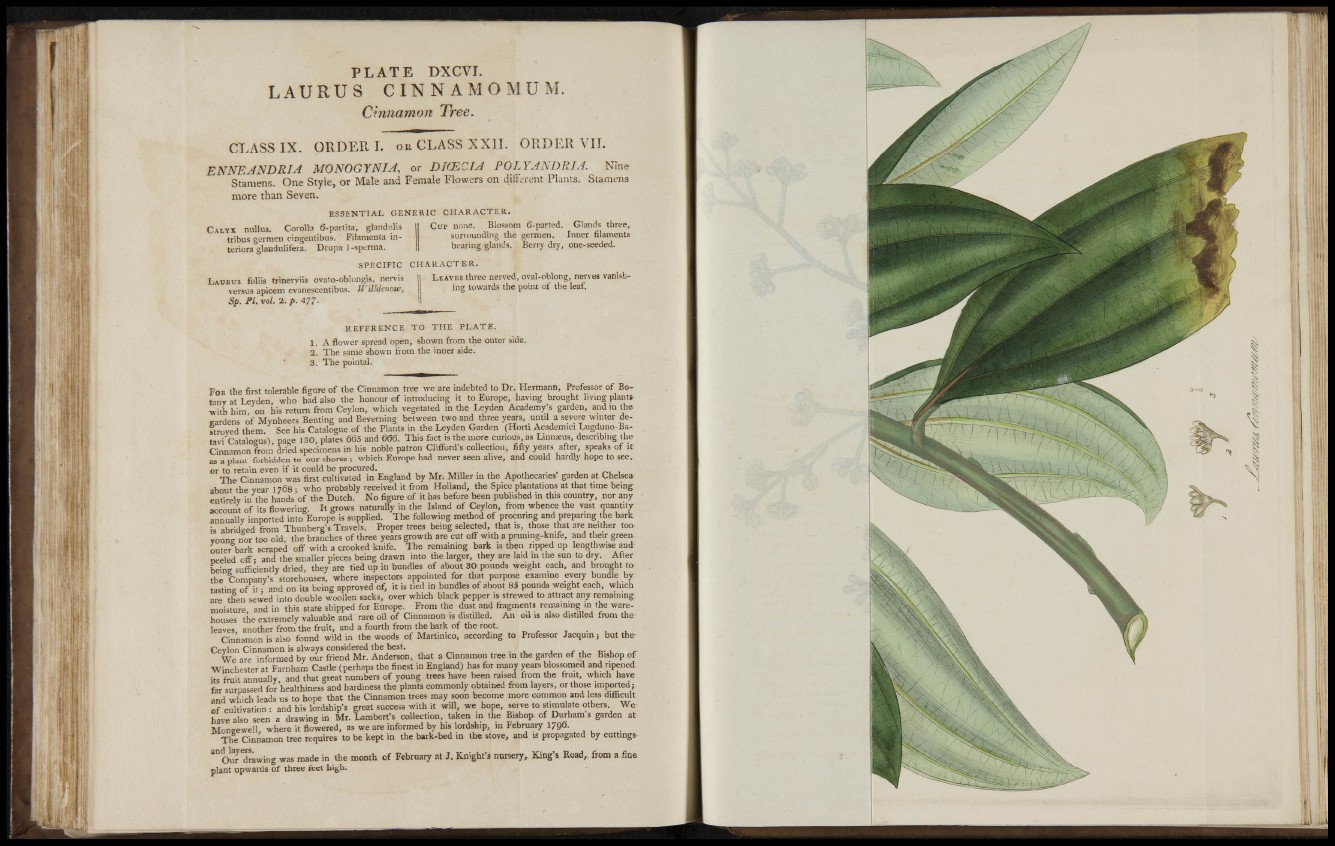
I
fi
'it i 'I
,i
nil i : ;
. r (
tM • ;
t
I J : ;
''ili i il
tIfV.
t i;
- :
• • !'.
; • "i
ii''!
i ;
iftiii
í I: ;
¿iv
i • !
P L A T E DXCVT.
L A U R U S C IN N A M. O M U M.
Crnnamon Tree,
CLASS IX. ORDER L on CLASS XXIL ORDER VIJ.
ENNEJNDRIA MONOGYNIA, or DTCECU POLYANDRIA. Nine
Stamens. One Style, or Mate and Female Flowers on diliirent Plants. Stamens
more than Seven.
ESSENTIAL GENERIC CHARACTER.
CALYX nullus. Corolb 6-parfita, glandulis
tribus germen cingenübus. Filanjenta interiora
glandulifera. Drupa 1-sperma.
Cup none. Blossom 6-parred. Glands three,
surrounding the germen. Inner filaments
bearing glands. Berry dry, one-seeded.
SPECIFIC CHARACTER.
LAUKUS foliis trinerviis ovato-oblongis, ner\'is
versus apicem evanescentibus. Willdenow,
Sp. PI. vol. 2. p. 477.
LEAVES three nerved, oval-oblong, nerves vanishing
towards the point of the leaf.
REFERENCE TO THE PLATE.
1. A flower spread open, shown from the outer side.
2. The same shown from the inner side.
3. The pointal.
FOR the first tolerable figure of the Cinnamon tree we are indebted to Dr. Hermann, Professor of Botanr
at Leyden who had also the honour of introducing it to Europe, having brought living plantswith
him on his return from Ceylon, which vegetated in the Leyden Academy's garden, and m the
cardens of Mynheers Benting and Beverning between two and three years, until a severe ^vinter destroyed
them See his Catalogue of the Plants in the Leyden Garden (Horti Academici Lugduno-Batavi
Cataloc'us) pa«e 130, plates 665 and 666. This fact is the more curious, as Lmnaeus, describing the
Cinnamon from dried specimens in his noble patron Clifford's collection, fifty years after, speaks of it
as a plant forbidden to our shores; which Europe had never seen alive, and could hardly hope to see,
or to retain even if it could be procured. - , . , • , . . ,
The Cinnamon was first cultivated in England by Mr, Miller m the Apothecaries garden at Chelsea
about the year 1768 ; who probably received it from Holland, the Spice plantations at that time being
entirely in the hands of the Dutch. No figure of it has before been published in this country, nor any
account of its flowering. It grows naturally in the Island of Ceylon, from whence the vast quantity
annually imported into Europe is supplied. The following method of procuring and preparing the bark
is abridoed from Thunberg's Travels. Proper trees being selected, that is, those that are neither too
voun2 nor too old, the branches of three years growth are cut off with a pruning-kmfe, and their green,
outer bark scraped off with a crooked knife. The remaining bark is then ripped up lengthwise and
neeled off; and the smaller pieces being drawn into the larger, they are laid in the sun to dry. After
L i n e sufficiently dried, they are tied up in bundles of about 30 pounds weight each, and brought to
the Company's storehouses, where inspectors appointed for that purpose examme every bundle by
tastine of it • and on its being approved of, it is tied in bundles of about 85 pounds weight each, which
are then sewed into double woollen sacks, over which black pepper is strewed to attract any remaining
moisture, and in this state shipped for Europe. From the dust and fragments remaimng in the warehouses
the extremely valuable and rare oil of Cinnamon is distilled. An oil is also distilled from the
leaves, another from the fruit, and a fourth from the bark of the rwt.
Cinnamon is also found wild m the woods of Martinico, accordmg to Professor Jacqum; but the
Ceylon Cinnamon is always considered the best. • .u j f .u p- u r
W e are informed by our friend Mr. Anderson, that a Crnnamon tree m the garden of the Bishop of
Winchester at Farnham Castle (perhaps the finest in England) has for many years blossomed and ripened
its fruit annually, and that great numbers of young trees have been raised from the fruit, which have
far surpassed for healthiness and hardiness the plants commonly obtained fi-om layers, or those importen;
and which leads us to hope that the Cinnamon trees may soon become more common and less difficult
of cultivation : and his lordship's great success with it will, we hope, serve to stimulate others We
have also seen a drawing in Mr. Lambert's collection, taken in the Bishop of Durham s garden at
Moneewell, where it flowered, as we are informed by his lordship, m February 1796.
The Cinnamon tree requires to be kept in the bark-bed in the stoye, and is propagated by cuttings
Ourdrawing was made in the month of February at J. Knight's nursery. King's Road,., from a fine
plant upwards of three feet high.